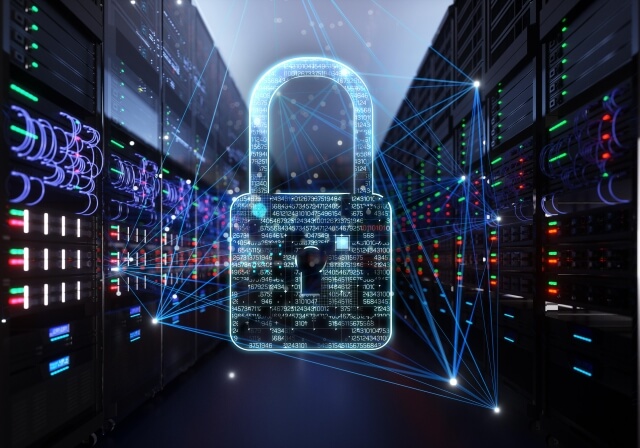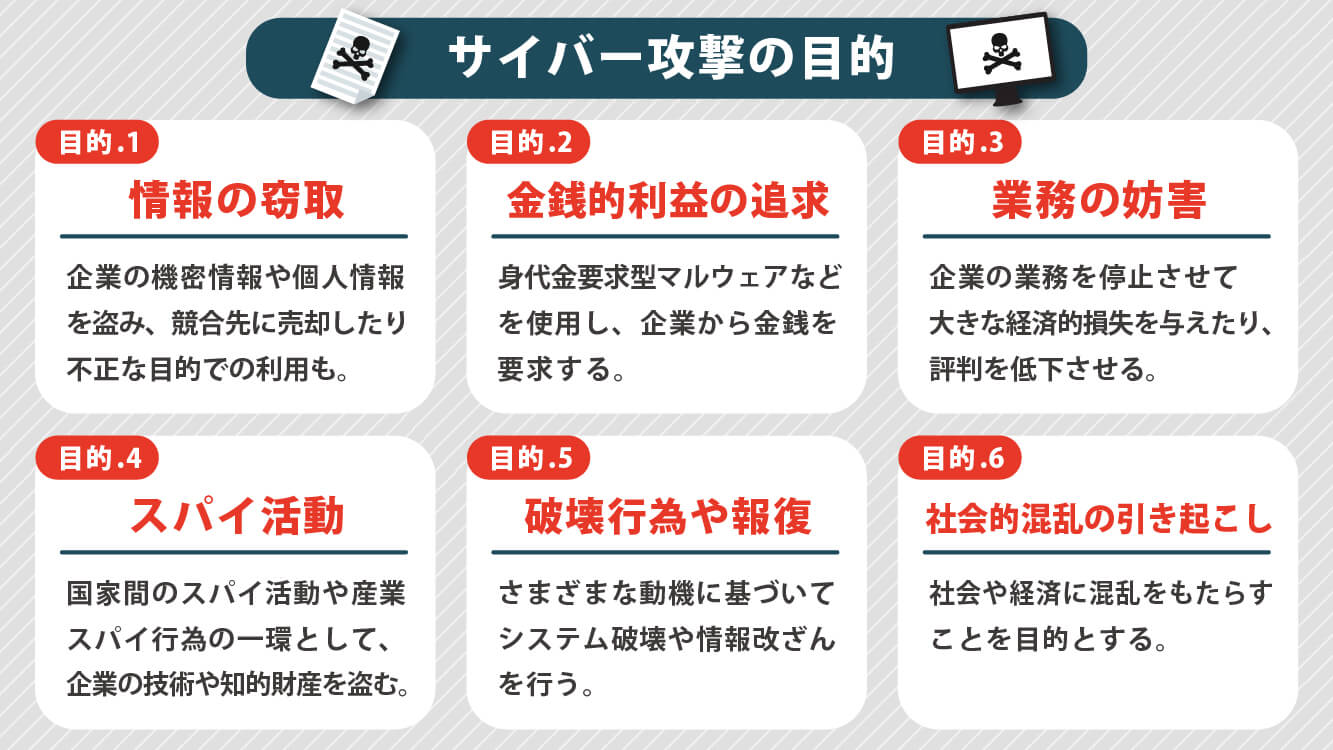2024.09.30
How to prevent information leaks due to cyber attacks? Employee training is also important!

In recent years, with the sophistication of cyber attacks, the risk of information leakage in companies has reached unprecedented levels. In this day and age, where anyone can be a target regardless of the size of the company, not only technical measures but also the awareness and actions of each employee hold the key to preventing troubles.
In this blog, we will delve into the importance of employee training to protect corporate information from cyber attacks, and provide a comprehensive explanation of typical methods of cyber attacks and the best preventive measures against them.
Table of Contents
1. Causes of Information Leakage and Current State of Cyber Attacks
1-1. Causes of Information Leakage
2. Typical Methods and Objectives of Cyber Attacks Leading to Information Leakage
2-1. Main Types of Cyber Attacks
2-2. Objectives of Cyber Attacks
3. Comprehensive Measures to Prevent Information Leakage from Cyber Attacks
4. Methods to Prevent Information Leakage from Targeted Attacks
5. Conclusion
1. Causes of Information Leakage and the Current State of Cyber Attacks
As the threat of cyber attacks increases year by year, customer information and confidential data held by companies are targeted, and cases of leakage continue to occur. First, let's organize the causes of information leakage.
Causes of Information Leakage

1. Virus Infection
Virus infection refers to the intrusion of malware (malicious software) into a company's system, which can lead to information theft or system destruction. Viruses are often spread through email attachments, websites, USB devices, and once infected, they can cause data breaches in various forms, such as "ransomware" that encrypts data and demands a ransom, or "spyware" that sends data externally.
2. Unauthorized Access
Unauthorized access refers to the act of malicious individuals, either external or internal, infiltrating a company's system without permission and stealing data. This includes methods such as password guessing or acquisition, and exploiting security vulnerabilities. Unauthorized access can lead to serious troubles and damages, as confidential information or personal data may be stolen, or systems may be manipulated.
3. Human Error
Human errors due to employee negligence are also a major cause of information leaks. For example, this includes accidentally sending confidential information to outsiders or failing to manage passwords properly. Additionally, inappropriate conversations in public places and mishandling of physical documents can also contribute to information leaks.
4. Unauthorized Removal and Theft
Information leakage can occur due to intentional misconduct or negligence by internal stakeholders. Unauthorized removal refers to the act of employees or contractors taking confidential information without permission, while theft can involve the physical taking of information such as devices or paper documents.
5. Vulnerable System Management
Old software and unpatched systems have security holes, making them prime targets for attackers. Additionally, if external data storage such as cloud services is used, inadequate management increases the risk of information leakage.
Among the main causes, virus infections and unauthorized access are included as types of cyber attacks.
According to the Tokyo Metropolitan Police Department, the most common cyber attack methods identified in 2023 exploit vulnerabilities in network devices, followed by targeted email attacks. Additionally, ransomware attacks are also prominent.
Understanding these factors and taking appropriate measures is essential to prevent information leaks.
2. Typical Methods and Objectives of Cyber Attacks Leading to Information Leaks

This chapter explains the typical methods of cyber attacks that companies should pay particular attention to.
Main Types of Cyber Attacks
●Standard Attack
This is an attack that infiltrates malware into a system to steal data or destroy the system. Examples include viruses, worms, trojans, and ransomware.
●Phishing
It is a technique used by attackers to deceive users into providing confidential data such as passwords and credit card information by using fake emails or websites. Since it resembles legitimate documents or screens, users are tricked into entering their information.
●DDoS (Distributed Denial of Service) Attack
This is an attack that uses multiple computers to send a large amount of traffic (signals and data sent and received) to a targeted server or network, causing the service to stop. As a result, websites and online services may become unavailable.
●SQL Injection
This is an attack that exploits vulnerabilities in websites and web applications by inserting malicious SQL code (a language used to manipulate databases) to steal or alter personal information.
●Man-in-the-Middle Attack (MITM Attack)
This is an attack that intercepts and alters data during communication. The attacker stands in between, stealing information between the user and the service provider or injecting false information.
●Zero-Day Attack
An attack that exploits vulnerabilities in software or systems before they are patched. Attackers may launch their attacks before the vulnerabilities are disclosed, making defense difficult.
In this way, we have learned that there are various methods of cyber attacks.
However, there may be some who are surprisingly unaware of the purposes behind these attacks. Let's take a closer look at the main objectives of cyber attacks.
Cyber Attack Objectives

●Purpose.1 Information Theft
The goal is to steal confidential information and personal data from companies. The stolen information may be sold to competitors or used for illegal purposes.
●Purpose.2 Pursuit of Financial Gain
There are cases where ransomware is used to encrypt data and demand money from companies. Additionally, there are cases where attackers infiltrate banking and financial institution systems to steal money directly.
●Purpose.3 Disruption of Business
The goal is to halt business operations of companies through denial-of-service (DoS/DDoS) attacks. This aims to inflict significant financial losses on the company and damage its reputation.
●Purpose.4 Spy Activities
The objective is to steal corporate technology and intellectual property as part of espionage activities between nations and industrial espionage. This includes attacks by states and attacks commissioned by competitors.
●Purpose.5 Destructive Acts and Retaliation
Based on political, religious, or personal motives, there may be acts of destroying systems or tampering with information. This includes politically motivated attacks known as hacktivism (hacker + activism).
●Purpose.6 Causing Social Disruption
There are also attacks aimed at causing disruption to society and the economy. This includes cyber attacks targeting critical infrastructure (such as power, transportation, and communication).
Understanding the methods and objectives of cyber attacks is the first step for companies to implement effective defense measures. Continuous enhancement of security measures is required against the evolving cyber threats in the future.
3. Measures to Thoroughly Prevent Information Leaks Due to Cyber Attacks

Companies that experience data breaches significantly lose trust and can sometimes incur substantial financial losses. This chapter introduces specific measures that companies should take to thoroughly prevent data breaches caused by cyber attacks.
Countermeasure 1: Implement the Latest Security Software
Security software is the frontline defense that protects systems from viruses and malware. Companies must always implement the latest security software to be able to respond to new threats. Additionally, it is important to use firewalls, intrusion detection systems (IDS), and intrusion prevention systems (IPS) to prevent unauthorized access to the network.
Countermeasure 2: Do Not Leave Software Vulnerabilities Unaddressed
Cyber attackers often exploit software vulnerabilities, so it is important to keep software and operating systems up to date. Updates often include security patches that fix known vulnerabilities. Additionally, utilizing vulnerability scanning tools to regularly check for vulnerabilities in networks and systems is also effective.
Countermeasure 3: Thorough Security Training for Employees
Cyber attacks can exploit human errors and ignorance. Therefore, regular security training for employees is essential. It is necessary to ensure that employees are well-informed about basic security knowledge, such as how to identify phishing emails and safe password management practices. Furthermore, it is reassuring to regularly conduct training and drills related to cybersecurity to enhance employees' response capabilities.
Countermeasure 4: Strengthen Access Control and Permission Management
To prevent information leakage, it is also important to strictly manage access permissions to confidential information. We thoroughly implement the "principle of least privilege," granting only the minimum necessary permissions and clearly defining who can access which data. Additionally, when accessing important data, implementing two-factor authentication (2FA) or multi-factor authentication (MFA) helps prevent impersonation and unauthorized access.
Measures.5: Thorough Data Encryption and Backup
To minimize the risk of information leakage, data encryption is also effective. Especially when handling confidential information or personal data, encrypting data not only during transmission but also when stored prevents easy decryption of the content in case the data is stolen. Additionally, regularly back up your data to prepare for any potential data loss. The principle is to store backups on a separate device.
Measures.6 Develop an Incident Response Plan and Establish a Rapid Response System
No matter how many measures are taken, cyber attacks cannot be completely prevented. It is important to anticipate emergencies and develop an Incident Response Plan, ensuring that a system is in place for rapid and appropriate response when incidents occur. The plan should include response measures for each stage, such as incident detection, initial response, impact mitigation, recovery procedures, and measures to prevent recurrence.
To prevent information leaks due to cyber attacks, a multifaceted approach is necessary, including not only technical measures but also employee training and incident response plans. Additionally, cybersecurity is not a one-time setup; it requires continuous improvement and adaptation. The key is to always enhance defenses while keeping up with the latest trends.
4. Methods to Prevent Information Leakage from Targeted Attacks

Among cyber attacks, targeted attacks tend to cause particularly significant damage, making it crucial for each employee to maintain vigilance and awareness. This is because the emails and messages crafted by attackers are very cleverly designed. Here, we will provide a detailed introduction on how to prevent information leaks caused by targeted attacks.
Method 1: Thoroughly educate employees on security awareness
Many targeted attacks are carried out through phishing emails and social engineering (exploiting human psychological weaknesses to steal information). Therefore, being aware of these tactics in advance is an effective preventive measure. It is advisable to establish training sessions to learn the characteristics and how to identify phishing emails, and to develop practical response skills through simulated training.
Method 2: Establish Rules for Information Sharing When Receiving Suspicious Emails
By setting up rules for information sharing in advance when receiving suspicious emails, you can detect signs of an attack early and help prevent the escalation of damage. It is advisable to establish rules regarding the reporting system, criteria for identifying emails, and methods for immediate alert notifications to the entire company. Strengthen the overall security of the organization through prompt information sharing and appropriate responses.
Method 3: Consideration of Response Measures When Targeted Attacks Occur
By preemptively considering how to respond in the event that an email is opened without realizing it is a targeted attack, damage can be minimized. Specifically, this includes promptly reporting to the IT department or security personnel, conducting a system audit to confirm the scope of impact, isolating potentially infected devices, and changing passwords or re-evaluating security measures. Additionally, it is important to provide training and establish guidelines in advance so that employees can respond quickly in such situations.
Method 4: Enhancing System Security
Keeping the OS and software versions up to date is one of the fundamental measures to prevent targeted attacks. Furthermore, regular log checks are also important. By regularly monitoring system logs, it becomes possible to quickly detect abnormal access or suspicious behavior and respond promptly.
By combining these measures, a comprehensive defense system can be established, which helps minimize the risk of information leakage.
5. Summary

To prevent information leaks due to cyber attacks, it is essential to regularly implement technical measures such as applying security patches and scanning for vulnerabilities. However, the most important aspect is that each employee understands the basics of security and practices appropriate responses.
An effective approach is information security training utilizing e-learning.
E-learning offers the convenience of being able to learn anytime and anywhere as long as there is an internet connection, and it has the advantage of making complex information in the field of security easier to understand through illustrations and animations.
In Human Science, we offer a variety of educational materials related to information security.
Among them, the "Information Security Fundamentals Course – Targeted Attacks" provides a detailed explanation from knowledge about criminal methods to practical countermeasures. We also accommodate customization and multilingual options for each company, so please feel free to contact us with any requests.
You can check the details of the teaching materials on the Human Science e-learning site.
>e-Learning Material "Information Security Basics Course - Targeted Attacks"












